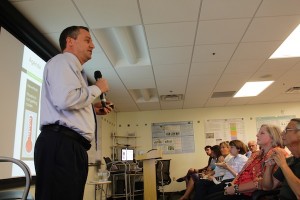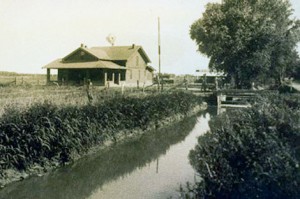June 17, 2012
 It’s no secret that living in Arizona during the summer can be quite the battle. With record temperatures soaring up, a group of experts specializing in how state residents can sustainably cope with these blistering sun rays gathered at the Global Institute of Sustainability last week to provide answers. The presentation touched on past, present, and the prospective future of dealing with the inevitable long, hot Arizona summers.
It’s no secret that living in Arizona during the summer can be quite the battle. With record temperatures soaring up, a group of experts specializing in how state residents can sustainably cope with these blistering sun rays gathered at the Global Institute of Sustainability last week to provide answers. The presentation touched on past, present, and the prospective future of dealing with the inevitable long, hot Arizona summers.
The speakers of this event also included:
Historically, the Phoenix area was a lush city with canals and plenty of trees shading the sidewalks. Buildings and houses had awnings that would shade windows in an effort to keep heat out. Irrigation canals would stimulate growth of trees and grass as well as a popular way for families to jump in for a swim in order to stay cool. Because air conditioning had not been invented yet, the implementation of shade and canals had made living in Arizona easier for residents.
 Farm home and irrigation canal two miles west of Mesa in the early 1900s. (Reclamation photograph) via National Register of Historic Places Multiple property Documentation Form, Salt River Project, Arizona, prepared by Jim Bailey, Bureau of Reclamation, June 2010.
Farm home and irrigation canal two miles west of Mesa in the early 1900s. (Reclamation photograph) via National Register of Historic Places Multiple property Documentation Form, Salt River Project, Arizona, prepared by Jim Bailey, Bureau of Reclamation, June 2010.
As we developed as a city, and as more people began to inhabit the Phoenix area, urban sprawl took action and the temperature began to rise. The continued construction of buildings and homes begins to rapidly grow to accommodate people, yet some have not been designed to accommodate the summer heat to provide energy efficiency. Sustainable design is a present initiative that stresses the importance of taking from history (implementing shade and an oasis environment) and planning the design of our newer buildings and homes to incorporate state-of-the-art design and technology toward energy efficiency and comfort from the heat to state residents.
The implementation of shade, plants, and sustainable design can save home and business owners significant money on their energy bill. Luis Salazar, architect for his firm Salazar Associates Architects Ltd., sees the future of all Arizona homes and businesses to incorporate just that. In his presentation, Salazar said that in order to achieve the first step of sustainable design we must embody logical and local characteristics. The sun is an example of both logical and local characteristics. When we design our buildings and homes, we have to remember that we live in an area with a vast abundance of sunlight. Salazar believes that we must move forward in utilizing energy from the sun to turn it into something beneficial to us. He sees the future city of Phoenix to have solar collectors on everything from buildings, to homes, to billboards. The sun is endlessly available in Arizona. It is necessary to incorporate the sun into sustainable design today for tomorrow’s buildings and homes.
The future of energy efficiency in Arizona is being discussed by a number of people. Mick Darlymple, the Project Manager of Energize Phoenix, explained that Energize Phoenix aims to save energy, create “green jobs”, and transform a diverse array of neighborhoods by offering cash incentives and financing to help pay for most energy efficiency improvement project costs for homes and businesses. The Energize Phoenix program was launched from a $25 million federal grant awarded to the city of Phoenix from the U.S Department of Energy Better Buildings Neighborhood Program and the American Recovery and Reinvestment Act (ARRA). Energize Phoenix works in partnership with ASU Global Institute of Sustainability (GIOS) and support from Arizona Public Service (APS).
In order to encourage the transition of greater energy efficient initiatives in Arizona, the Arizona Corporate Commission (ACC) is also working on improved energy efficient and renewable energy standards. The ACC plans to have Arizona’s public utilities required to achieve annual energy savings of at least 22% by 2020, with the savings to increase incrementally as a percent of retail energy sales in each prior calendar year to reach that goal. Up to one-third of the energy savings can result from energy efficient building codes and up to one-third of the savings can come from energy efficient appliance standards. Not only do home and business owners save money by energy efficiency improvement projects, but they also are reducing the amount of heat that is generated from using outdated energy standards.
I learned a lot from this enjoyable and thought provoking presentation; therefore, I would like to close on a few energy saving tips, told to me by Mick Darlymple, which will give you the biggest bang for your buck.
Energy tips you can do today to save:
Written by Gabrielle Olson, ASU LightWorks
Photo retrieved from Shawn Raymundo, ASU State Press
Additional Information:
http://sustainability.asu.edu/events/rsvp/phoenix-summer-2012
http://www.azcc.gov/Divisions/Administration/news/100727Energy%20Efficiency.pdf
http://www.statepress.com/2012/06/13/experts-discuss-summer-energy-efficiency/

